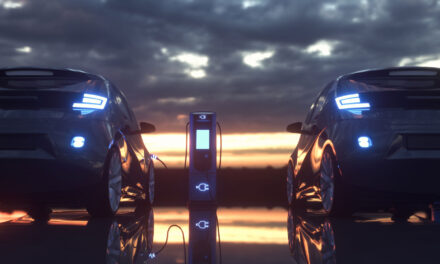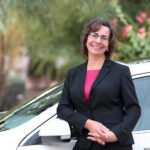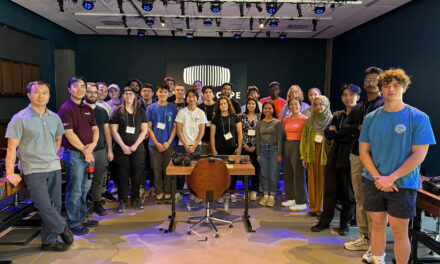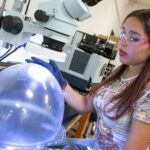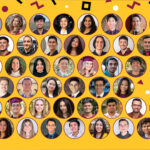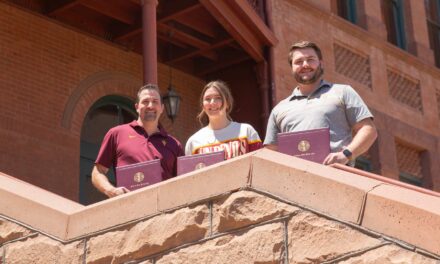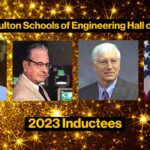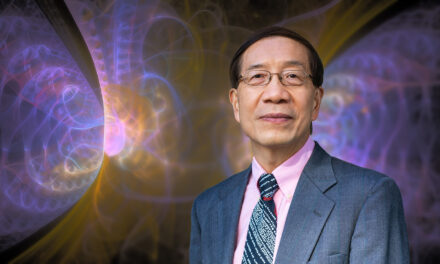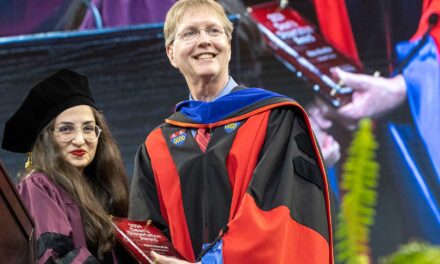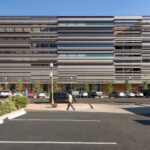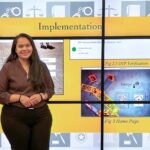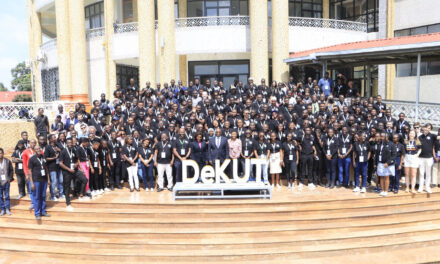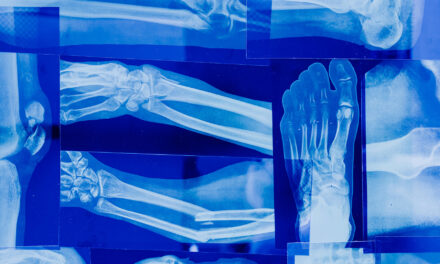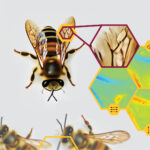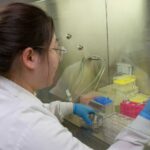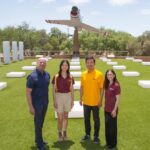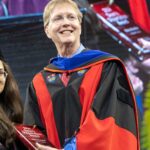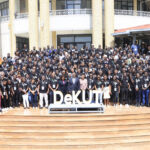
Engineering beyond the classroom: ASU students conduct use-inspired research in health, sustainability and innovative imaging
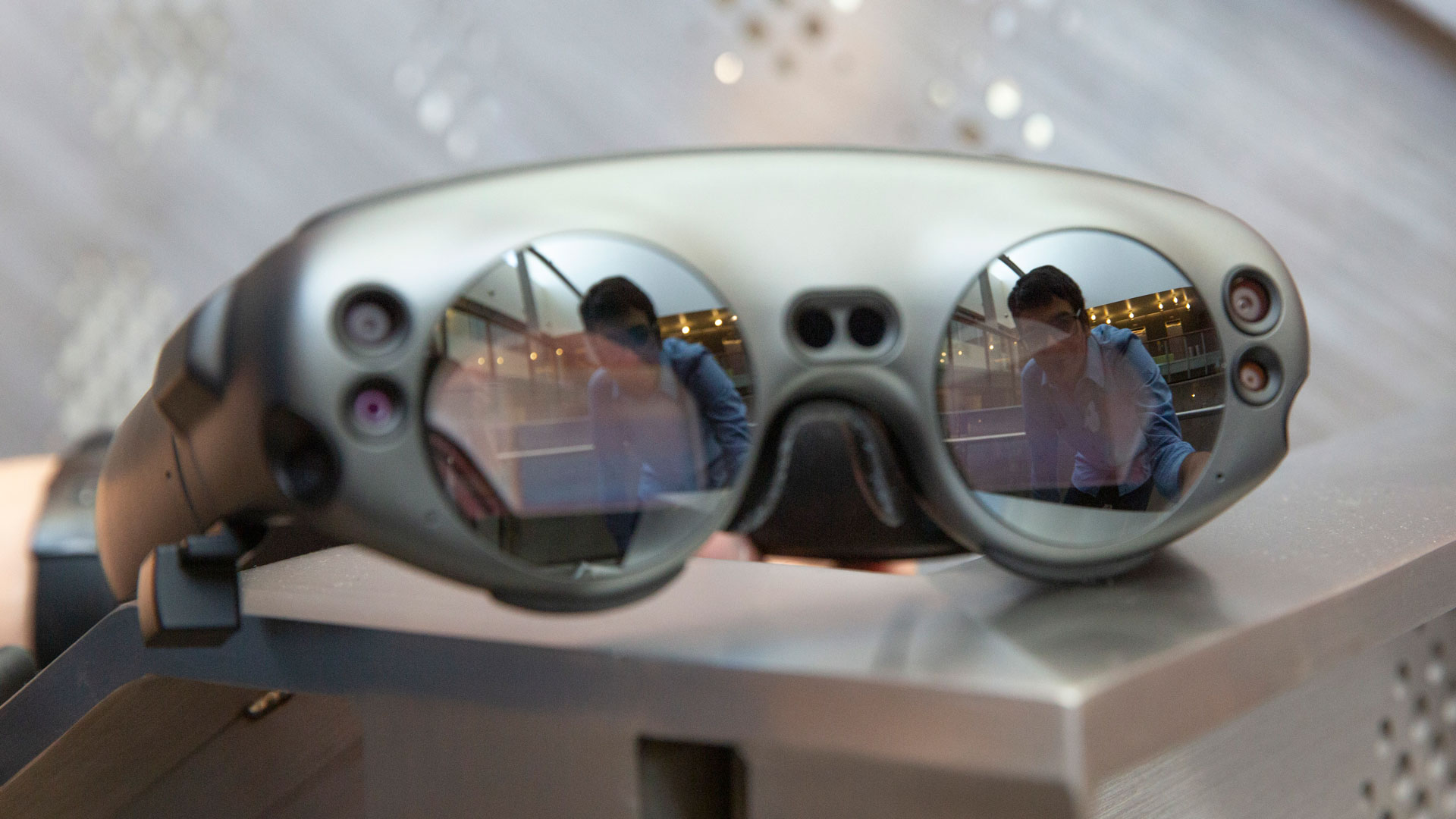
Above: Arizona State University electrical engineering graduate student S. Saketha Ramanujam Samavedam peers into the lenses of an imaging device that can see around obstacles. Samavedam is conducting research in the Master’s Opportunity for Research in Engineering program, one of the research programs that students in the Ira A. Fulton Schools of Engineering at ASU can participate in to enhance their classroom experience through hands-on learning with faculty mentors. Photographer: Erika Gronek/ASU
This article is the first in a two-part series highlighting student researchers and faculty mentors presenting at the Fall 2021 FURI Symposium on November 19 on the ASU Tempe campus. Read part two. Learn more about the symposium.
Engineering and technology students can enhance their education by applying classroom knowledge and learning new skills through hands-on research. They’re also profoundly affecting their communities — both local and global — by pursuing research topics that interest them.
Undergraduate and graduate students can take advantage of multiple opportunities in the Fulton Schools to engage in research that addresses real-world challenges in data science, education, energy, health, security and sustainability.
The Fulton Undergraduate Research Initiative, or FURI, and the Master’s Opportunity for Research in Engineering, or MORE, programs challenge students to spend a semester conceptualizing an idea, developing a plan and investigating their research question with a faculty mentor.
Students in the Grand Challenges Scholars Program, or GCSP, can choose to take on a research project as part of the program’s required competencies that uniquely prepare them to solve challenges we face as a global society.
These three opportunities promote growth in students’ ability to innovate, think independently and solve problems they see in their communities. They also help students gain skills that will support their careers or pursuits to earn advanced degrees.
Students who participate in FURI, MORE and GCSP are invited to present their research findings at the biannual FURI Symposium.
Learn about five Fulton Schools students and a faculty mentor participating in the Fall 2021 FURI Symposium. Meet these students and more than 80 other student investigators at the event, open to the public, held on Friday, November 19, 1–3 p.m. on the ASU Tempe campus.
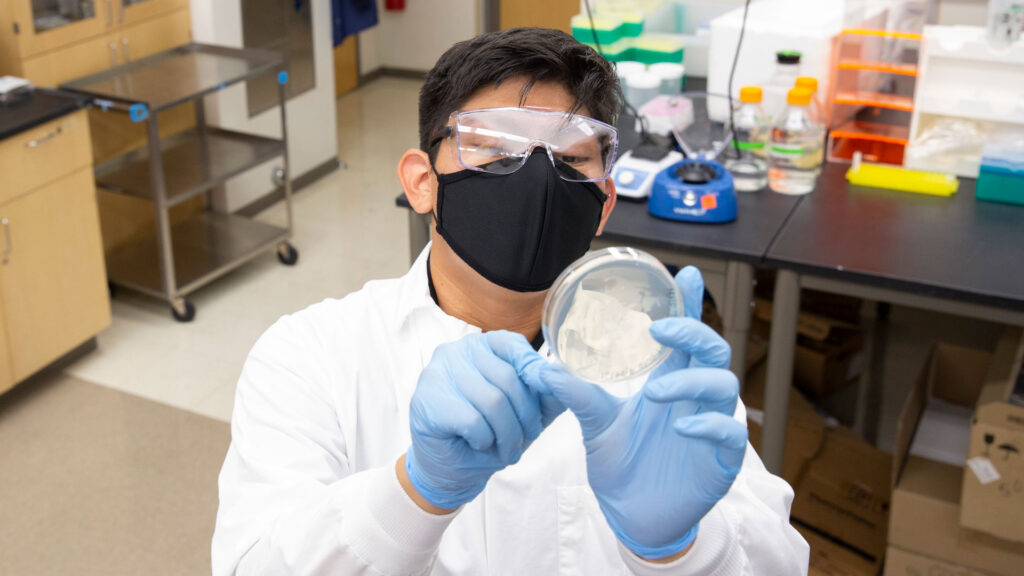
Biomedical engineering senior Margarito Hernandez Fuentes is researching gene therapies for pleural mesothelioma cancer with Christopher Plaisier, an assistant professor of biomedical engineering. Photographer: Erika Gronek/ASU
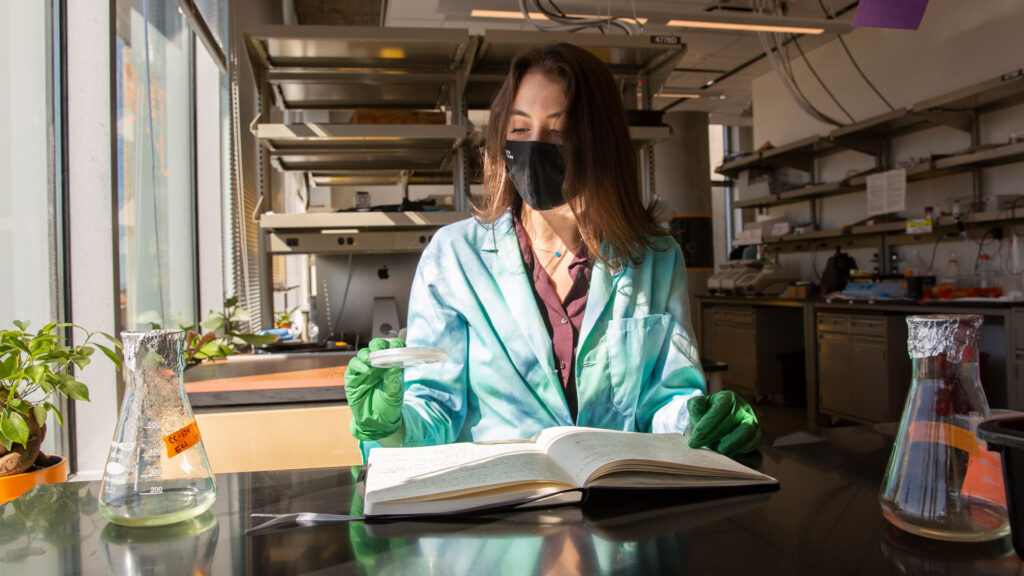
Biomedical engineering senior Emma Lieberman is researching decontamination techniques to reduce arsenic in local groundwater with Christopher Plaisier and Benjamin Bartelle, two assistant professors of biomedical engineering. Photographer: Erika Gronek/ASU
Read more about Margarito Hernandez Fuentes
Why did you choose the project you’re working on?
I chose to work on cancer biology research because I am interested in the wet lab aspect of bioengineering. The thought of using engineering to solve critical health issues never fails to excite me. I am especially interested in using bioengineering approaches to solve health disparities. With my research project, I hope to do just that.
How will your engineering research project impact the world?
Pleural mesothelioma is a malignant cancer with a grim survival rate. Current treatment options are insufficient and come with devastating effects. My research project aims to find alternative treatment options by inhibiting the growth of the cancer through gene silencing. With my research, I hope to move one step closer to revolutionizing cancer treatment and provide better outcomes for patients struggling with this disease.
What has been your most memorable experience as a student researcher?
One memorable experience was finally being able to see so many concepts and techniques I learned in class being used in my research lab. It was exciting learning so many new lab techniques and being able to understand their role in my experiment.
How do you see this experience helping you with your advanced degree goals?
As an aspiring physician-scientist, this experience will prepare me to tackle research questions from an engineering approach. With a background in bioengineering, I see myself approaching health issues through a new lens. In addition, I am more than certain that the lab techniques learned from this experience will be used consistently through my pursuit of a graduate degree.
Why should other students get involved in this program?
For undergraduates looking to gain any experience in research, the FURI program is the best way to do just that. While students are more than able to conduct research outside of FURI, this program dedicates its resources and mentors to hone students’ research and presentation skills.
Read more about Emma Lieberman
Emma Lieberman is a biomedical engineering senior in the Grand Challenges Scholars Program who is presenting water decontamination research conducted with Assistant Professor Christopher Plaisier in the FURI Symposium. Lieberman worked on her talent competency of GCSP through opportunities with the ASU iGEM competition team and research with Plaisier and Assistant Professor Benjamin Bartelle.
What made you want to get involved in GCSP?
I was originally drawn to the Grand Challenges Scholars Program my freshman year. I like that it gives undergraduates the opportunity to contextualize everything we’re learning in the real world, and helps us consider how to provide value through our work.
How will your engineering research project impact the world?
For this project, I was a member of ASU’s team participating in the International Genetically Engineered Machine, or iGEM, annual competition. iGEM puts a lot of emphasis on addressing local issues ethically. As a co-captain for the team, and the head of our human practices efforts, we explored how prolonged exposure to high arsenic concentrations in water can have devastating effects on people, livestock and the environment. Hopefully, this project and the proposed filter design and implementation method we developed will help people have better access to safe drinking water. This would help people in rural communities to maintain the integrity of their environment and live healthier lives.
How do you see this experience helping your career?
Being a member of GCSP will help me show my dedication to improving lives and providing value to our society through biomedical engineering. Participating in the iGEM competition has been an amazing learning opportunity. I’ve learned a plethora of skills that will help me immensely in my career — not only wet lab skills, but also project planning, leadership and research skills that I am excited to utilize in future projects.
What is the best advice you’ve gotten from your faculty mentor?
Dr. Plaisier advised us to design our protocols thoroughly, check them with others and run them at least once before we needed to. This was great advice. No matter how thoroughly you think the protocols are researched, there is always something that will come up when you’re in the lab. It’s also helpful knowing that the cloning issues, lab setbacks and failed experiments happen to everyone, and can almost always be solved with a little more time, research, meetings with advisors and trial and error.
Why should other students get involved in GCSP?
I highly recommend other Fulton Schools students become involved in GCSP regardless of their engineering major. It is encouraging to be part of a community that is so optimistic about improving lives with our engineering skills. I also recommend that students become involved in future ASU iGEM teams. This year reignited our team and we hope to take an active part in this annual competition for many years to come!
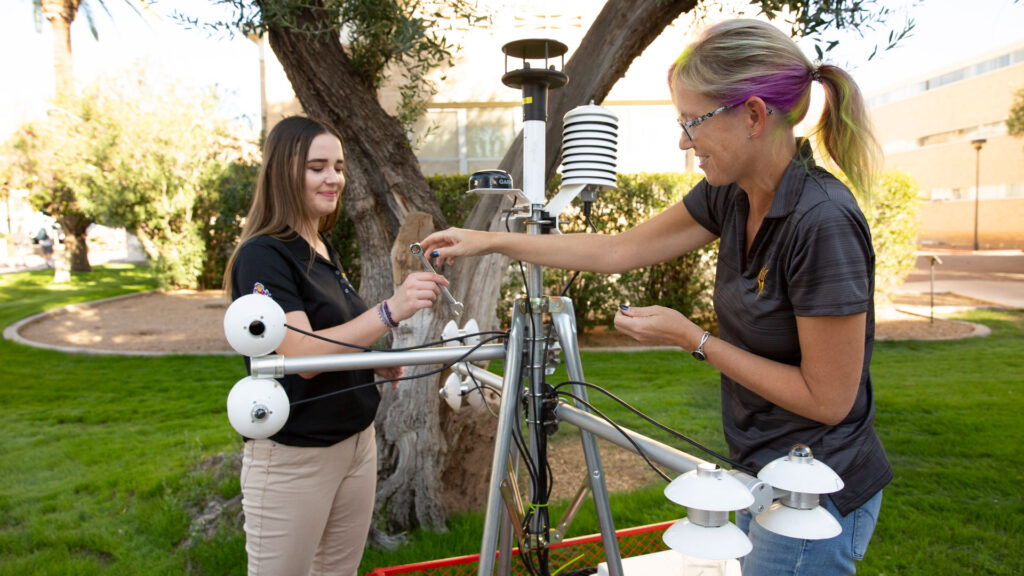
Computer science senior Maya Muir (left) is working with Ariane Middel (right), an assistant professor in the School of Arts, Media and Engineering in the Ira A. Fulton Schools of Engineering at ASU, to develop a tool to help urban planners create effective shading structures to protect people from extreme heat. Photographer: Erika Gronek/ASU

Electrical engineering graduate student S. Saketha Ramanujam Samavedam is researching mmWave radar imaging technology with George Trichopoulos, an assistant professor of electrical and computer engineering, to help develop methods to see around obstacles and corners. Photographer: Erika Gronek/ASU
Read more about Maya Muir
Computer science senior Maya Muir is making heat data more functional for urban planners through a FURI research project with Assistant Professor Ariane Middel and Professor Ross Maciejewski. FURI is one of many programs Muir is involved in at the Fulton Schools, which provides this unique opportunity to conduct impactful research as an undergraduate student.
What made you want to get involved in FURI?
I wanted to get involved in this program because it is a great way to broaden my knowledge and work closely with faculty members. I chose the project I am working on because I am interested in data analytics and data visualization. The project also positively impacts the community, which is important to me.
How will your engineering research project impact the world?
It equips us to better handle the increasing temperatures caused by climate change. With this tool, urban planners will be able to build more effective shading structures that will protect the public from extreme heat.
How do you see this experience helping with your career?
This experience helps me advance my career goals because it provides me with a real-world problem to solve. Not only will I be making an impact on the community, but I will also be improving my skills. I have been working with programming languages that I have never had to use in my classes before. This experience will help set me apart from other candidates when applying for jobs.
Why should other students get involved in this program?
FURI is a great opportunity provided to Fulton Schools students. You will be able to build relationships with faculty members while also working on a project that interests you. This program allows students to strengthen and build upon their technical and problem-solving skills.
Read more about S. Saketha Ramanujam Samavedam
When electrical engineering graduate student S. Saketha Ramanujam Samavedam heard about the MORE program during student orientation, he knew he had to apply. He has always been interested in all kinds of research, and this semester he has worked with Assistant Professor George Trichopoulos to explore imaging techniques that will enable us to see around obstacles.
What made you want to get involved in MORE?
I’ve always been interested in research of all sorts — math to medicine and engineering to space science. I was informed of the MORE program during my orientation days by the then-participants, and I immediately knew I had to apply for this program.
Why did you choose the project you’re working on?
I was introduced to the possibilities of non-line-of-sight imaging with mmWaves by Dr. Trichopoulos as part of our coursework, and it seemed interesting and I felt that it would be a challenging problem to solve for real-time use. While I like the idea of processing things in real time, the highlight of this project is the idea of getting to peek at non-line-of-sight objects.
How will your engineering research project impact the world?
This research will empower a class of devices that enable mixed-reality/augmented-reality headsets to look for objects in the non-line-of-sight domain, enabling soldiers or security personnel to look for potential threats. It will serve as an additional utility for first-response teams to locate and rescue people stuck in non-line-of-sight zones during times of disasters and distress.
Have there been any surprises in your research?
Not all things come with manuals and sometimes we have to improvise from the given text or reference documents to find our way around using a hardware device. This has very much been a surprise to me given that all of the projects that I had worked upon previously had information in one form or another documented in related areas.
What is the best advice you’ve gotten from your faculty mentor?
Always look for parallels, do not reinvent the wheel and when stuck, discuss or read the idea out loud — you’ll know why that particular step or method is leading to an unfruitful outcome.
Why should other students get involved in MORE?
Research in general is often deemed a road not for everyone. While I believe there are challenges in obtaining the results we expect, there is joy in discovery and elation once the research we’ve been working on starts yielding results. If you are in doubt and are questioning if research is for you, don’t worry, find a faculty member, ask them about their work, meet the students who work with them, volunteer your time, maybe seek a position in their lab and apply away. The only way to know if you are built for it is to try and MORE gives you that opportunity to try.
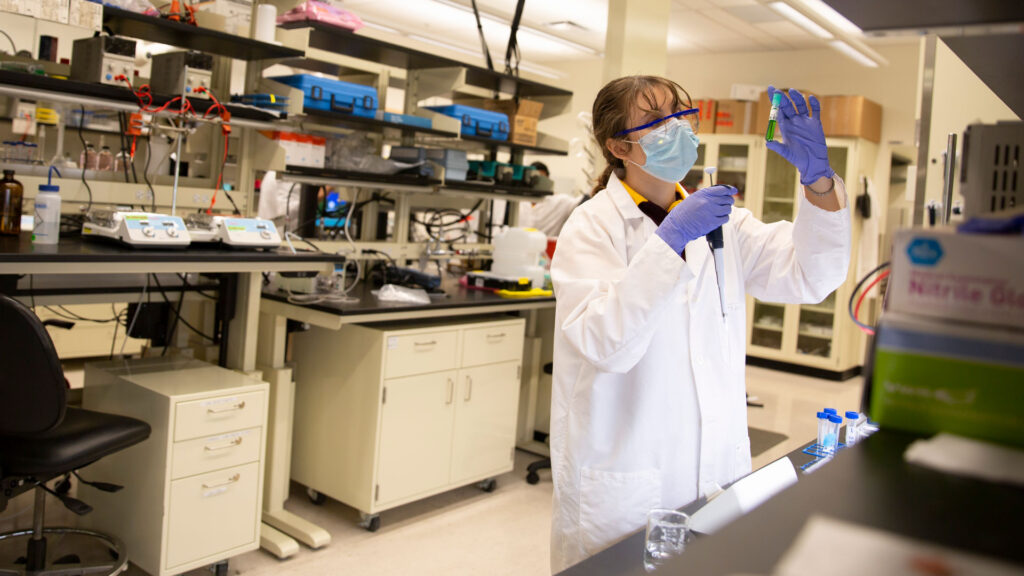
Environmental engineering senior Annika Wines is conducting research with Sergi Garcia-Segura, an assistant professor of civil, environmental and sustainable engineering, to develop a process to remove nitrates from drinking water and sustainably produce valuable ammonia for fertilizer. Photographer: Erika Gronek/ASU
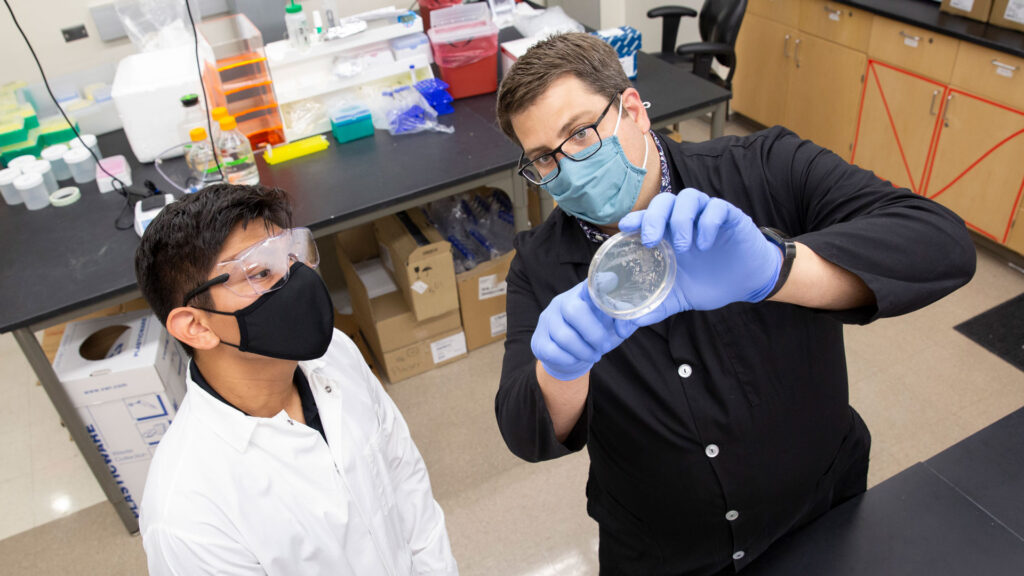
Assistant Professor Christopher Plaisier (right), works with biomedical engineering student Margarito Hernandez Fuentes as a faculty mentor in the Fulton Undergraduate Research Initiative program. Photographer: Erika Gronek/ASU
Read more about Annika Wines
Annika Wines is an environmental engineering senior conducting sustainable ammonia production with Assistant Professor Sergi Garcia-Segura. She is passionate about solving difficult challenges in sustainability and the built environment, which she is accomplishing through her FURI project.
What made you want to get involved in FURI?
I met my mentor as a student in one of his classes and was interested in the research he was doing. I began as a volunteer in his lab and applied for FURI the next semester.
How will your engineering research project impact the world?
Our engineering project will support sustainability goals while improving access to safe drinking water. Nitrate removal is energy-intensive and often requires chemical treatment, causing waste. The Haber-Bosch process currently contributes 1.4% of global greenhouse emissions to produce ammonia for fertilizer. The goal of this project is to create an alternative to the Haber-Bosch process while removing harmful levels of nitrate from potable water sources in an affordable, accessible way. We are doing so through electrodeposition of common earth metals onto an affordable nickel medium. This project seeks to serve communities all over the world, especially isolated and rural communities where problems of water quality and inaccessibility of technology persist.
What has been your most memorable experience as a student researcher?
The most memorable moment in my research was when my mentor and graduate student Gabriel Carron Calle and I saw desired levels of ammonia yield too high for our equipment to detect. It was very exciting for us because it is everything we have been working for in the past semester.
Read more about Assistant Professor Christopher Plaisier
Christopher Plaisier, an assistant professor of biomedical engineering, has been mentoring FURI and MORE students for three years. His work focuses on genetic research for discovering diagnostic and prognostic biomarkers and new drug targets. In his lab, Plaisier trains his students to be cross-disciplinary researchers.
What made you want to get involved as a FURI faculty mentor?
Undergraduates are at the start of their professional careers. Any skills and experience they pick up now will considerably impact their growth into biomedical engineers. Mentoring undergraduate students through FURI allows me to train the next generation of interdisciplinary engineers who can tackle the big problems we currently face.
What is your favorite part about seeing your students conduct research?
In a classroom, students learn the basic principles that will make up what they will likely undertake in their careers. Researching real-world projects puts those principles into action and brings home why those ideas are so important. This contextualization of ideas is a fundamental step in learning, and it always amazes me how meaningful these experiences are.
How have your student researchers had an effect on your research? Have they come up with any research surprises or proposed new directions for your lab?
The FURI students in my lab have pushed forward an immunotherapy angle that was not initially part of my research plan. The results have been very impressive, and we are gearing up to conduct some validation studies shortly. Additionally, a FURI student has pushed forward a website for our mesothelioma gene regulatory networks that will be released as soon as the manuscript on that work is published sometime next year.
What have you gained from being a FURI mentor? How has the experience been rewarding for you?
I benefited greatly from mentors who took the time to teach me the practical side of research. This extra training beyond my undergraduate studies has been instrumental in my success. I hope to foster an environment where students can gain research skills and experience. I enjoy training, mentoring and working with undergraduate students. The FURI program has helped me to retain students from first-years to seniors. It is rewarding to see each student grow in knowledge, experience and confidence and see how they apply themselves after graduating from ASU.
What advice would you give to students who might be interested in participating in FURI or MORE?
Go for it. It is vital for students to learn what research is before they commit to graduate studies. FURI is an excellent opportunity for students to learn whether research is something they would like to pursue in the future. Also, FURI and MORE are great opportunities to learn things beyond what you get in the classroom. For those considering graduate school, you should absolutely apply for FURI. Just find a professor whose research interests you and see if they would support you and apply! The odds are good!
Why should other faculty members become FURI or MORE mentors?
Mentorship is essential for students to find their place in the field of engineering. Faculty mentorship is an investment in the future of engineering and ensures that the field is filled with well-trained, excited and diverse people. We faculty members need to seize the opportunity represented by so many capable undergraduates, and FURI is a great incentive to recruit students into the lab.
Learn more about the student projects for which Plaisier is a mentor


